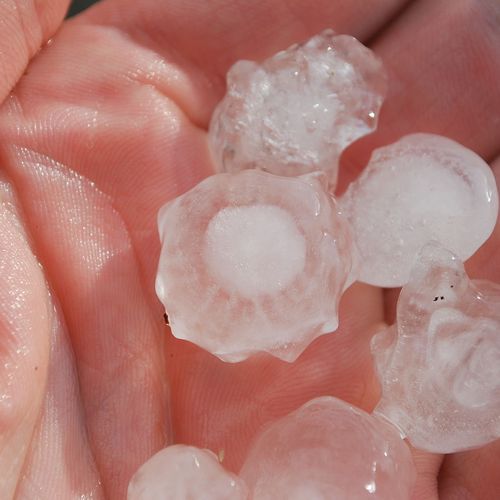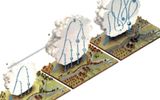
| Added | Fri, 20/01/2023 |
| Sources | |
| Феномены | |
| Version type |
Hail is a type of heavy rainfall in the form of ice particles of predominantly rounded shape (hailstones).
Hail is ice particles of spherical or irregular shape (hailstones) ranging in size from a millimeter to several centimeters, but there are hailstones measuring 130 mm and weighing about 1 kg. The unattainable absolute record holder was hailstones weighing 7 kilograms, observed in April 1981 in Guangdong Province, China.
Hailstones consist of layers of transparent ice with a thickness of at least 1 mm, alternating with translucent layers. It falls, as a rule, in the warm season from powerful cumulonimbus clouds, strongly developed upwards, usually during showers and thunderstorms.
The layer of fallen hail is sometimes several centimeters. The duration of precipitation: from a few minutes to half an hour, most often 5-10 minutes, and very rarely — about 1 hour or more. Hail falls mostly in the summer and during the day. Hail at night is a very rare phenomenon.
Chemical analysis of the water collected from the hailstones showed that they contained organic substances, as well as clay particles and quartz grains. Such extraneous inclusions are not uncommon in hailstones. Most often they are located in the central part of hailstones and represent either a grain of sand, or a particle of ash, or an organic body, and sometimes meteor dust. Sometimes the dust contained inside the hailstones is red, which gives the hailstones a reddish hue.
It happens that objects raised by a strong upward air flow fall out with hail, for example, stones, pieces of wood, etc. So, on June 4, 1883, stones the size of nuts, consisting of rocks of the Scandinavian Peninsula, fell together with hail in Vestmonland (Sweden) (Nordenskjold, ed. Vetenskaps Akademien 1884, No. 6); in Bosnia, in July 1892, a lot of small fish from the bleak breed fell together with rain and hail (Meteorological Bulletin 1892, p. 488). The phenomenon of hail is accompanied by a special characteristic noise from the stress of hailstones, resembling the noise that occurs from the precipitation of nuts.
Hail is usually accompanied (some believe that even always) by a thunderstorm and occurs in small thunderstorms (tornadoes, tornadoes) with a strong upward current of air, arising and moving in ordinary cyclones.
Related facts
Log in or register to post comments


![The forms of hailstones are described in the "Meteorological Review" by PROF. A.V. Klossovsky ("Proceedings of Meteor. networks of the South of Russia" 1889, 1890, 1891).They are presented on the table in full size. More shaded places correspond to less transparent parts of hailstones. g. fell in southwestern Russia:Fig. I — in Chernihiv province in 1876.;Fig. II — in the Kherson province. in the same year;Figs. III, V, VI, VII, VIII, IX [In the "Hail" table there is a group of six hailstones (in the lower half of the table). mistakenly designated by the Roman numeral XI, instead of it should be IX], X, XI — in the Kherson province in 1887.;Fig. IV — in the Tauride province in 1887.;Fig. XII — in the Podolsk province.;Fig. XIII — in the Tauride province in 1889.;Fig. XV — in the Minsk province in 1880.;Fig. XVI — in Odessa in 1881.Especially remarkable are the forms depicted in Fig. IX (a, b, c, d, e, f, g, h, i) [1], which fell out in the Kherson province, in the village. Zelenovka Elizavetgradsky u., Aug. 19, 1887, on the day of a total solar eclipse, about an hour after the end of the eclipse, with a strong SW vortex (Fig. in the text); the middle consists of dark blue ice with a depression; around it is like a faience white circle, dirty in places, apparently with dust; it is followed by ice petals, of which two inner rows are the color of white earthenware, the last row is the color of ordinary ice. The g. depicted in Figures IX b and C. Fig. have a similar shape. IX d is a spherical shape, transparent with white thin stripes on the surface. Fig. IX e — flat, slightly concave, white. IX h and i are parallelepipedal, transparent, or milky in color, or the color of white faience.](https://ik.imagekit.io/u4ftyhke2kx/storage/tr:h-100,w-160/nt_version/65374/11-6207.jpeg?ik-sdk-version=php-2.0.0)




![The forms of hailstones are described in the "Meteorological Review" by PROF. A.V. Klossovsky ("Proceedings of Meteor. networks of the South of Russia" 1889, 1890, 1891).They are presented on the table in full size. More shaded places correspond to less transparent parts of hailstones. g. fell in southwestern Russia:Fig. I — in Chernihiv province in 1876.;Fig. II — in the Kherson province. in the same year;Figs. III, V, VI, VII, VIII, IX [In the "Hail" table there is a group of six hailstones (in the lower half of the table). mistakenly designated by the Roman numeral XI, instead of it should be IX], X, XI — in the Kherson province in 1887.;Fig. IV — in the Tauride province in 1887.;Fig. XII — in the Podolsk province.;Fig. XIII — in the Tauride province in 1889.;Fig. XV — in the Minsk province in 1880.;Fig. XVI — in Odessa in 1881.Especially remarkable are the forms depicted in Fig. IX (a, b, c, d, e, f, g, h, i) [1], which fell out in the Kherson province, in the village. Zelenovka Elizavetgradsky u., Aug. 19, 1887, on the day of a total solar eclipse, about an hour after the end of the eclipse, with a strong SW vortex (Fig. in the text); the middle consists of dark blue ice with a depression; around it is like a faience white circle, dirty in places, apparently with dust; it is followed by ice petals, of which two inner rows are the color of white earthenware, the last row is the color of ordinary ice. The g. depicted in Figures IX b and C. Fig. have a similar shape. IX d is a spherical shape, transparent with white thin stripes on the surface. Fig. IX e — flat, slightly concave, white. IX h and i are parallelepipedal, transparent, or milky in color, or the color of white faience.](https://ik.imagekit.io/u4ftyhke2kx/storage/tr:h-1178,w-900/nt_version/65374/11-6207.jpeg?ik-sdk-version=php-2.0.0)


